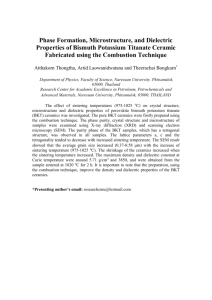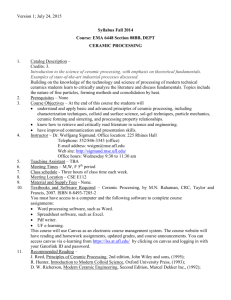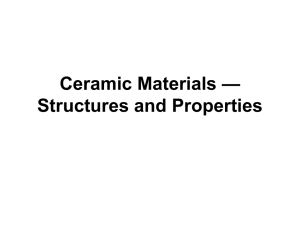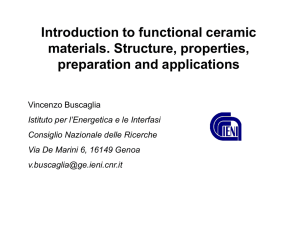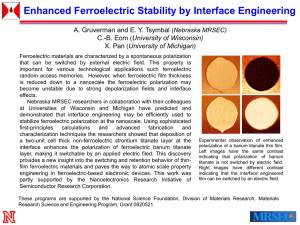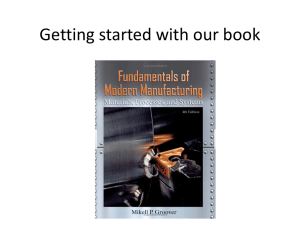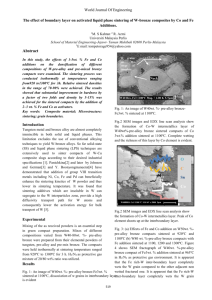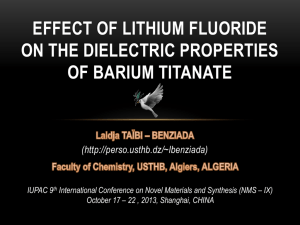Processing Electroceramics - School of Materials and Mineral
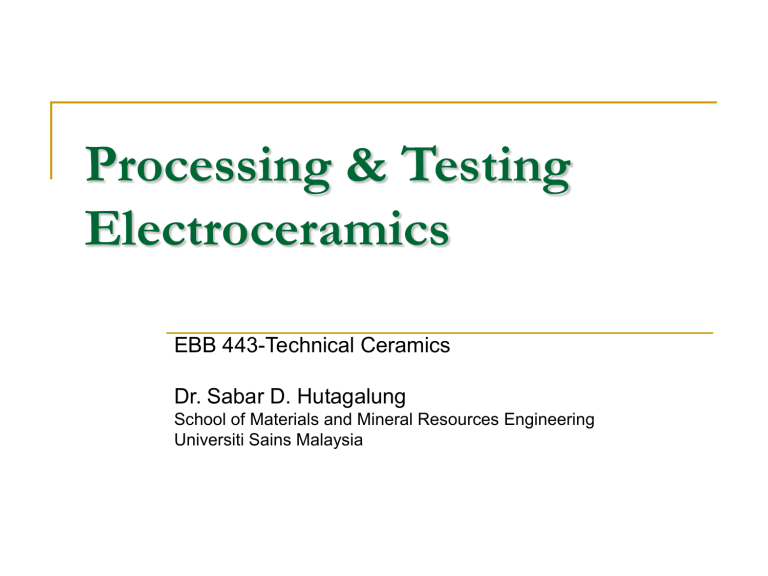
Processing & Testing
Electroceramics
EBB 443-Technical Ceramics
Dr. Sabar D. Hutagalung
School of Materials and Mineral Resources Engineering
Universiti Sains Malaysia
Processing of Electroceramics
The properties of electroceramic components greatly depend upon the processing conditions of the ceramic.
The raw materials are first weighed according to the stoichiometric formula.
The raw materials should be of high purity.
The particle size of the powders must be in the submicron range for the solid phase reactions to occur by atomic diffusion.
The powders are then mixed either mechanically or chemically.
Mechanical mixing is usually done by either ball milling or attrition milling for a short time.
Processing of Electroceramics
During the calcination step the solid phase reaction takes place between the constituents giving the electroceramic phase.
The calcining temperature is important as it influences the density and hence the electromechanical properties of the final product.
The higher the calcining temperature, the higher the homogeneity and density of the final ceramic product.
Processing of Electroceramics
After calcining, the lumps are ground by milling.
The green bodies should have a certain minimum density before they can be sintered.
The desired shape and a minimum green density can be provided by various techniques including powder compaction, slip-casting, and extrusion .
The choice of the method depends on the type of powder used, particle size distribution, state of agglomeration, desired shape, and thickness of the part.
After shaping, the green bodies are heated very slowly in order to remove any binder present.
Processing of Electroceramics
The binder burnout rate should be
1-2 ° C/min in order to allow the gases to come out slowly without forming cracks and blisters in the ceramic part.
After the binder burnout is over, the samples are taken to a higher temperature for sintering to take place.
The sintering temperature and time should be optimum for proper densification to occur without abnormal grain growth.
The sintering of oxide ceramics must be carried out in an oxidizing atmosphere or in air .
Solid State Reaction
The above technique is refer as a solid state reaction or conventional method.
In briefly, the steps including:
Mixing or milling (dry or wet milling)
Calcination
Compaction (for pellet formation)
Sintering
Example: Solid State
Reaction of CCTO
XRD Analysis
(calcined powders)
Ball milling 1 hour of a stoichiometric ratio of raw materials (CaCO
3
, CuO & TiO
2
)
Calcination 900 o C/12 hrs.
Compaction with pressure 300
MPa (thickness ~0.5-1.0 mm)
Dielectric measurement by using LCR meter
Sintered sample with silver electrodes
Sintering at 1050 o C for 12 hrs.
XRD Analysis (sintered pellets)
Production scheme of ‘Nd2Fe14B-type’ magnets (REM XIII,
1994 p 303)
Processing of ferroelectric ceramics
Flowchart for the processing of ferroelectric ceramics
Processing of ferroelectric ceramics
The dipoles within a single domain have the same orientation.
In ferroelectric ceramics with fine grain sizes
(< 1 m m) each grain is a single domain with the domain wall at the grain boundary.
If the grain size is larger (> 1 m m) then there could be multiple domains in a single grain.
Processing of ferroelectric ceramics
Piezoelectric behavior can be induced in a ferroelectric ceramic by a process called "poling".
In this process a direct current (dc) electric field with a strength larger than the coercive field strength is applied to the ferroelectric ceramic at a high temperature, but below the Curie point.
On the application of the external dc field the spontaneous polarization within each grain gets orientated towards the direction of the applied field.
Processing of ferroelectric ceramics
Schematic of the poling process in piezoelectric ceramics: (a) In the absence of electric field the domains have random orientation of polarization; (b) the polarization within the domains aligns in the direction of the applied field.
Slip Casting Method
Modified domestic microwave oven used for the powder synthesis.
In a typical experiment, a solid mixture containing requisite quantities of aluminum nitrate, magnesium nitrate, and urea was taken in a Pyrex glass dish and was irradiated with microwaves in a modified domestic microwave oven (Microwave 700W, input range 210 –230 V-ac 50 Hz, microwave frequency 2.45 GHz) to produce MgAl
2
O
4 spinel material.
MW Irradiation?
In conventional or surface heating, the heat flow rate into the body from the surface determined by its specific heat, thermal conductivity, density and viscosity.
Surface heating is not only slow, but also non-uniform with the surfaces being much hotter than the inside of the material.
Consequently, the quality of conventionally heated materials is variable and frequently inferior to the desired result.
1050 o C/4 h 1050 o C/24 h
MW Irradiation?
Conversely, with microwaves, it is possible to heat the volume of a material at the same rate.
Energy is transferred through the material electro-magnetically, not as a thermal heat flux.
Therefore, the rate of heating is not limited and the uniformity of heat distribution is greatly improved.
Heating times can be reduced to a very short time.
Methodology
MW kitchen oven
(2.45 GHz, 1.1 kW).
XRD analysis
(calcined powder)
Ball milling 5 h of stoichiometric ratio of CaCO
3
, CuO, TiO
2
.
MW irradiation 30-90 min
Compaction , 520 MPa
(d ~1.2-1.5 mm, Ø 5 & 12 mm)
MW sintering 60 min
Dielectric measurement
Samples with silver electrodes
SEM analysis
(surface & fracture)
Post-MW sintered
30-150 min
Sintering at
1000 o C/10h
Domestic MW oven (2.45 GHz, 1.1 kW)
Alumina
Susceptor/Crucible
SiC/graphite
Sol-Gel Processing
Sol-Gel Processing: Basic Reactions
Sol-Gel: Steps of film formation
Sol-Gel: Stability of sols
Unique structures by sol-gel
Sol-Gel: Multilayer
Ceramic sol-gel films
Testing
XRD analysis
(calcined powder)
Ball milling 5 h of stoichiometric ratio of CaCO
3
, CuO, TiO
2
.
MW irradiation 30-90 min
Compaction , 520 MPa
(d ~1.2-1.5 mm, Ø 5 & 12 mm)
MW sintering 60 min
Dielectric measurement
Samples with silver electrodes
SEM analysis
(surface & fracture)
XRD analysis
(sintered sample)
Sintered pellet
Dielectric Testing
Dielectric Testing
Piezoelectric Measurement
PIEZO software takes input on the Multichannel from displacement or force sensors to collect piezoelectric properties simultaneously with electric properties.
